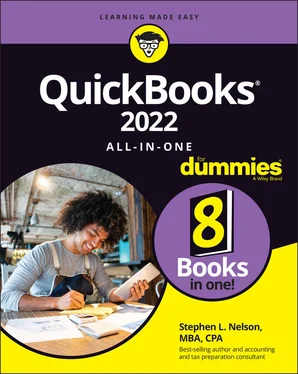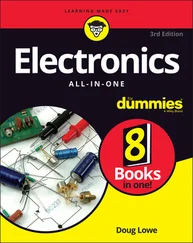Just to put these comments together, then, QuickBooks automatically creates most journal entries for you, builds a trial balance by using journal entry information, and — when asked — produces financial statements. Most of the work of double-entry bookkeeping, then, goes on behind the scenes. You don’t worry about many journal entries on a day-to-day basis. And if you don’t want to ever see a trial balance, you don’t have to. In fact, if you use QuickBooks only to produce invoices and to write checks that pay the bills, almost all the information that you need to prepare your financial statements gets collected automatically. So that’s really neat.
 Not all the information that’s necessary for producing good, accurate financial statements gets collected automatically. You’ll encounter a handful of important cases that should be handled on a special basis through journal entries that you or your CPA must construct and enter.
Not all the information that’s necessary for producing good, accurate financial statements gets collected automatically. You’ll encounter a handful of important cases that should be handled on a special basis through journal entries that you or your CPA must construct and enter.
Chapter 3
Special Accounting Problems
IN THIS CHAPTER
 Sorting out accounts receivable and accounts payable
Sorting out accounts receivable and accounts payable
 Keeping track of inventory
Keeping track of inventory
 Figuring out fixed assets
Figuring out fixed assets
 Finding out about asset write-downs
Finding out about asset write-downs
 Recognizing liability
Recognizing liability
 Handling revenue and expense account closings
Handling revenue and expense account closings
Even if you understand the principles of accounting (which I describe in Book 1, Chapter 1) and the basics of double-entry bookkeeping (which I describe in Book 1, Chapter 2), you still may not have all the information that you need to keep good records. Tracking the amounts that customers owe you and the amounts that you owe vendors can be a bit tricky, for example. Inventory can also present challenging record-keeping problems — a fact that’s not surprising to you as a retailer. And things like fixed assets … oh, don’t even get me started.
For these reasons, this chapter describes the most common complexities that business owners confront. You don’t need to be an accountant or an experienced bookkeeper to understand the material in this chapter. You do need to proceed carefully, take your time, and think a bit about how the material I describe here applies to your specific business situation.
Working with Accounts Receivable
If you read Book 1, Chapter 1, you already know that accounting principles state that sales revenue needs to be recognized when a sale is made and that the sale is made when a business provides goods or services to a customer.
In other words — and this point is really important — sales revenue doesn’t get recorded when you receive payment from a customer. Sales revenue gets recorded when a customer has a legal obligation to pay you because you have (or your business has) provided the customer the goods or services.
This requirement to record sales revenue at the time that goods or services are provided means that accounting for sales revenue is slightly more complicated than you may have first guessed. The first transaction — the transaction that records a sale — is shown in Table 3-1.
TABLE 3-1Journal Entry 1: Recording a Credit Sale
| Account |
Debit |
Credit |
| Accounts receivable |
$1,000 |
|
| Sales revenue |
|
$1,000 |
Journal Entry 1 shows how a $1,000 sale may be recorded. The journal entry shows a $1,000 debit to accounts receivable (sometimes abbreviated A/R ) and a $1,000 credit to sales revenue. To record a $1,000 sale — a credit sale — the journal entry needs to show both the $1,000 increase in accounts receivable and the $1,000 increase in sales revenue.
When the business receives payment from the customer for the $1,000 receivable, the business records a journal entry like that shown in Table 3-2.
TABLE 3-2Journal Entry 2: Recording the Customer Payment
| Account |
Debit |
Credit |
| Cash |
$1,000 |
|
| Accounts receivable |
|
$1,000 |
Journal Entry 2 shows a $1,000 debit to cash, which is the $1,000 increase in the cash account that occurs because the customer has just paid you $1,000. Journal Entry 2 also shows a $1,000 credit to accounts receivable. This credit to the accounts receivable asset account reduces the accounts receivable balance.
At the point when you record journal entries 1 and 2, the net effect is a $1,000 debit to cash (showing that cash has increased by $1,000) and a $1,000 credit to sales revenue (showing that sales revenue has increased by $1,000). The $1,000 debit to accounts receivable and the $1,000 credit to accounts receivable net to zero.
If you think about this accounts receivable business a bit, you should realize that it makes sense. Although the accounts receivable account includes a $1,000 receivable balance, this just means that the customer owes you $1,000. But when the customer finally pays off the $1,000 bill, you need to zero out that receivable.
QuickBooks, by the way, automatically records journal entries 1 and 2 for you. Journal Entry 1 gets recorded whenever you issue or create a customer invoice. Therefore, you don’t need to worry about the debits and credits shown in Journal Entry 1 except on one special occasion: When you set up QuickBooks and QuickBooks items, you do specify which account should be credited to track sales revenue. So although you may not need to worry much about the mechanics of Journal Entry 1, you should understand how this journal entry works so that you can set up QuickBooks correctly. (Book 2, Chapter 1describes the mechanics of setting up QuickBooks.)
 Items are things that get included in the invoices.
Items are things that get included in the invoices.
Journal Entry 2 also gets recorded automatically by QuickBooks. QuickBooks records Journal Entry 2 for you whenever you record a cash payment from a customer. You don’t need to worry, then, about the debits and credits necessary for recording customer payments. I find that it’s helpful, however, to understand how this journal entry works and how QuickBooks records this customer payment transaction.
Estimating bad-debt expense
One other important journal entry to understand is shown in Table 3-3.
TABLE 3-3Journal Entry 3: Recording an Allowance for Uncollectible Accounts
| Account |
Debit |
Credit |
| Bad-debt expense |
$100 |
|
| Allowance for uncollectible A/R |
|
$100 |
Journal Entry 3 records an estimate of the uncollectible portion of accounts receivable. (Businesses that don’t want to keep accrual-based accounting statements may not need to worry about Journal Entry 3.) Unfortunately, some of the money you bill customers may be uncollectible. Yet Journal Entry 1 records every dollar that you bill your customers as revenue. Therefore, you need a way to offset, or reduce, some of the sales revenue by the amount that ultimately turns out to be uncollectible.
Читать дальше

 Not all the information that’s necessary for producing good, accurate financial statements gets collected automatically. You’ll encounter a handful of important cases that should be handled on a special basis through journal entries that you or your CPA must construct and enter.
Not all the information that’s necessary for producing good, accurate financial statements gets collected automatically. You’ll encounter a handful of important cases that should be handled on a special basis through journal entries that you or your CPA must construct and enter. Sorting out accounts receivable and accounts payable
Sorting out accounts receivable and accounts payable










